Salem, Massachusetts Guide
Think of Salem, think of witches. Although the fame of the Salem witch trials has spread around the world, Salem's real renown comes from its ships, mariners and authors. Actually, there never were any witches in Salem!
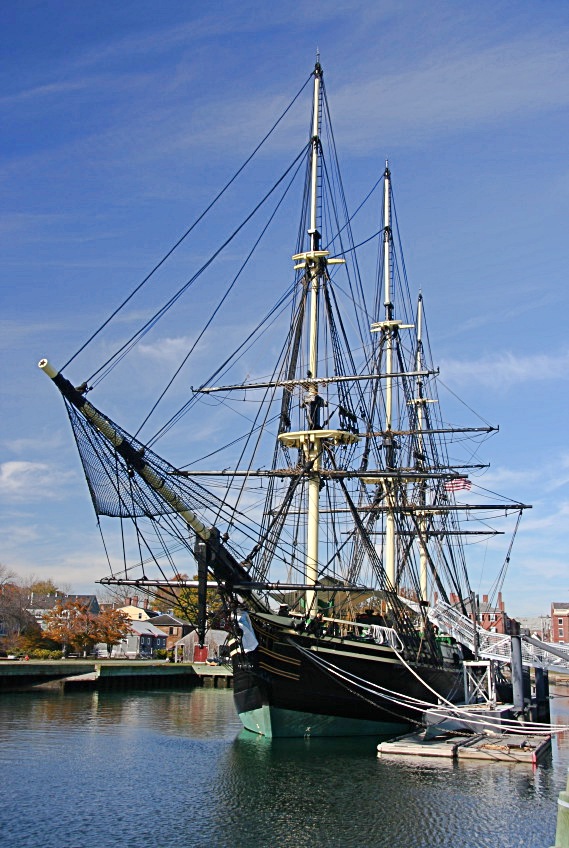
The Friendship, a square-rigged clipper ship that brought the wealth of the world to Salem MA, creating America's first millionaires. In the distance on the right is the Custom House.
Founded in 1626, by the late 1700s Salem MA, 17 miles (27 km) northeast of Boston (map), had grown and prospered. Its ships sailed around the world, many dealing in trade from the Orient, especially spices, silks, and other luxury goods.
The wealth of the Indies brought great prosperity to this New England port town, which enabled its citizens to build and decorate fine mansions and impressive museums.
What to See & Do in Salem
Salem's history is really that of its rich maritime commerce. The city's prime sights are the Salem Maritime National Historic Site, the Peabody-Essex Museum, and the fine houses built with the wealth brought from the Indies—not to mention the House of the Seven Gables, immortalized in the story by Nathaniel Hawthorne.
Salem Common
Officially named Washington Square, the Common is now Salem's large, pleasant, historic central park (map), with the Hawthorne Hotel. at its southwest corner, the famous statue of Roger Conant ("The Puritan") at the eastern end of Brown Street, and the Salem Witch Museum across the street from the statue. Surrounding streets hold many old houses—some dating from the 1600s—and 18th- and 19th-century mansions in good repair. Several fine mansions have become inns.
The Common is a favorite place to take a break from sightseeing. Like the more famous Boston Common, the park began as the town's common pasture land, to which each Salem citizen could bring a cow to graze.
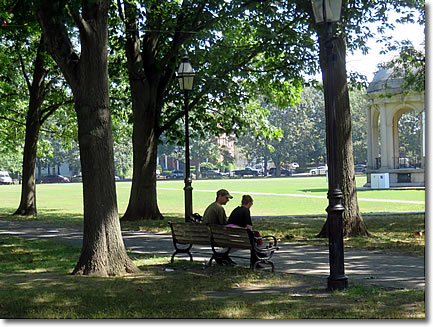
A quiet moment on Salem Common...
Salem Common Playground for toddlers and kindergartners, plus a basketball court, is in the southeast corner of the Common on Washington Square South.
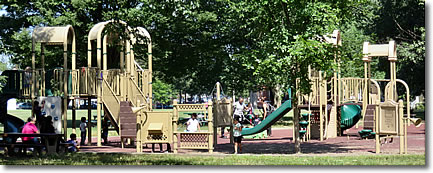
Sun & shade on Salem Common Playground...
MA Route 1A passes right along the edge of the Common via the streets named Washington Square North and Washington Square West.
The Puritan Statue
The famous grim-looking statue of Roger Conant (alias The Puritan) stands by Salem Common in front of the Salem Witch Museum, not far from the Hawthorne Hotel.
Although usually thought to represent the grim severity of Puritanism, the spectral Mr Conant was actually one of the good guys in early Salem, providing an example of courage and perseverance when the going got tough for the young colony founded in 1630.
Nathaniel Hawthorne Statue
On Hawthorne Boulevard in the small mall beside the Hawthorne Hotel stands a statue of Nathaniel Hawthorne, Salem's most famous author.
Hawthorne worked for a time in Salem's Custom House. He and his wife and daughter are buried in Concord MA's Sleepy Hollow Cemetery.
Salem Maritime National Historic Site
Salem MA produced America's first millionaires, merchants who earned fabulous wealth by sending speedy clipper ships around the world in search of high-value goods for import and export. The Custom House and other buildings in the Salem Maritime National Historic Site, have displays of Salem's (and America's) maritime history.
In 1937, the National Park Service took over the Salem Custom House, where Nathaniel Hawthorne once worked, and Derby Wharf in front of it, as a basis for the Salem Maritime National Historic Site, 174 Derby Street (map).
Today the site includes several other buildings and a full-sized replica of the Friendship, one of the ships that made Salem rich enough to produce America's first millionaires in the 1800s.
First thing to do is to pick up free copies of the National Park Service's brochure, which has a sketch map and directory of the buildings as well as short histories of the prominent Derby merchant family and of the adventures of several famous Salem vessels, both merchantmen and privateers ("legal" pirates).
The Salem Maritime National Historic Site also includes the Derby House, built in 1762 for the shipping magnate Elias Derby by his father, Captain Richard Derby, and the West India Goods Store, right next to Derby House, open for business and selling teas, coffee (beans and brew), spices, and other treasures from the East.
The National Park Service guides are well informed, as usual, and daily in July and August will take you on a tour back to the Bonded Warehouse to show you what cargoes were like and how they were handled, measured, and weighed.
You can also tour the Friendship, a full-size replica of a 1797 Salem three-masted square-rigged ship that sailed the world in the 1800s, bringing its wealth back to Salem's docks. The Friendship is moored on Derby wharf right in front of the Custom House.
Salem Maritime National Historic Site is a main feature of the Essex National Heritage Area, established in 1996 to organize thousands of historic places in Essex County around three historic themes: colonial settlement, maritime trade, and New England's early industrialization in the textile and shoe industries.
For hours of opening, see the Salem Maritime National Historic Site website.
The historic House of the Seven Gables is only a short walk from the Maritime Historic Site, so that should probably be your next sightseeing goal.
House of the Seven Gables
This 17th-century Salem house served as the setting for Nathaniel Hawthorne's novel of the same name. Salem's House of the Seven Gables, also known as the Turner-Ingersoll Mansion, is at 115 Derby Street (map), only a short walk from the Salem Maritime National Historic Site and the dock for the Salem Ferry to and from Boston.
The house is the centerpiece of a historic site with five houses and period gardens on Salem harbor.
Costumed interpreters greet you after you've paid the admission fee, and guide you through the museum's several buildings, which include the House of the Seven Gables (1668), Hooper-Hathaway House (1682), Hawthorne's birthplace (c. 1750), Counting House, and Retire Becket House (1655).
Peabody Essex Museum
Part of the historic center has been restored and closed to traffic as the fine pedestrians-only Essex Street Mall (map), where you'll find the Peabody-Essex Museum ("The P.E.M."), among the top reasons to visit Salem.
The East India Marine Society (1799) founded "a museum in which to house the natural and artificial curiosities" brought back from their worldwide voyages. Today, it's a must-see for any visitor interested in art, culture and history. Besides its rich collection of art and artifacts brought back by Salem's world-ranging 19th-century sea captains, it's also one of New England's top fine arts museums.
When a group of Salem sea captains and world travelers formed the East India Marine Society in 1799, their charter included provisions for the foundation of "a museum in which to house the natural and artificial curiosities" that the Society's intrepid captains might bring home from their commercial voyages.
This was the genesis of the Peabody Essex Museum, America's oldest museum in continuous operation, located on the Essex Street pedestrian mall, at the corner of New Liberty Street (map).
The Peabody Museum and Essex Institute, dedicated to the preservation, study, and exhibition of historical works and artifacts dealing with Essex County, began as separate institutions with similar purposes, and merged in the 1990s.
The resulting Peabody Essex Museum now ranks among America's major museums for Asian art (Japanese, Chinese, Korean, Indian). Because of Salem's intrepid sailors, ship captains and merchants, it boasts the finest collection of Asian Export art extant, and 19th-century Asian photography.
It collections of Native American, African, and Oceanic art were the first to be made. It also controls several historic houses and gardens, distinguished collections of American decorative art and maritime art.
All in all, Peabody Essex is one of New England's greatest art and history resources, with nearly two and a half million works of art.
The New England maritime collections include portraits of captains, pictures of ships, scale models, figureheads, old navigation instruments and tools, scrimshaw, prints, and gear from the whaling era, plus porcelain, paintings, furniture, and silver from Salem's China trade.
There's even a reproduction of the saloon (main cabin) of America's first oceangoing yacht, Cleopatra's Barge, built in 1816 by a member of the East India Marine Society.
Collections of objects from everyday life in primitive Polynesia, Micronesia, Melanesia and preindustrial Japan are rated among the best in the world. The intact Yin Yu Tang House is the only Qing dynasty house outside China.
Here is a list of some of the special collections you can look over: clocks, ceramics, military uniforms and weapons, dolls and toys, glassware, buttons, silver and pewter, lamps and lanterns, sculpture, tools, costumes from earlier centuries, and bits and pieces from the China trade, as well as a very good collection of Massachusetts works of art including paintings and furniture.
Witches?
As for witches, there never were any in Salem! The witch-hunt took place in only one year (1692), and the score of people executed met that fate because they would not admit to being witches! Many of the less courageous "admitted" being witches so that they wouldn't be executed.
The whole witch-calling affair fizzled out when people in power began to be accused.
The rest of the world enjoys remembering this bizarre episode, and spooky-dressed revelers throng Salem each Hallowe'en for weird fun and frolic.
In this city that had no real witches, the witch business is thriving, with at least a dozen witch attractions, plus several dozen "dark-arts" paraphernalia shops, bookshops, clothing and costume stores. You'll probably see would-be witches, warlocks and hangers-on wander Salem's pretty streets on any day, and they fill the hotels, inns and pensions every Hallowe'en.
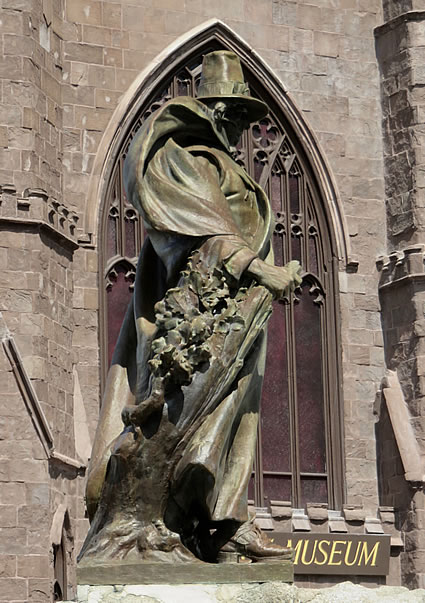
The statue of Roger Conant, The Puritan, seems to stride by a Gothic window in the Salem Witch Museum.
Salem Witch Trials Memorial
The Salem Witch Trials Memorial off Charter Street in Salem MA commemorates the suffering and martyrdom of the 24 people who died as a result of the Salem witch hunts of 1692. Put to death by hanging, crushing weights, or disease in jail, the Memorial is a cautionary reminder of innocents sacrificed to justice gone awry.
Accusations and Trials
Fear of witchcraft was common during the 1600s. Many people had been charged, tortured, found guilty and burned at the stake in Europe in centuries past.
The belief that a person could make a pact with the devil and gain extraordinary powers was brought with the Puritans to the colonies of Massachusetts Bay. Reverend Cotton Mather, the fiery hellfire-and-damnation Puritan preacher, wrote what many believed to be the definitive book on witchcraft, its methods and practices.
Before 1692, 44 people in Massachusetts Bay had been accused of witchcraft, and three had been sentenced to death and executed.
In March 1692, two girls near Salem, Betty Parris and her cousin Abigail, perhaps influenced by Cotton Mather's witchcraft text, began acting as though "possessed" by the devil.
The girls accused a half-black, half-Indian slave woman named Tituba of witchcraft. Under torture and fear of death, Tituba "confessed" to being a witch, begged forgiveness to save her life, and accused two other women of having joined her as witches.
Soon the accusations were being made by everyone, about everyone. Even prominent clergy, merchants and other leading personages were being accused.
Six months after Betty and Abigail started the madness, 156 people had been accused and 55 had pleaded "guilty," implicating others to save their own lives. Fourteen women and five men who refused to confess were found guilty and hanged, and four others died in jail of illness. One man who refused to plead either guilty or not guilty had boards and heavy stones stacked upon him until he was crushed to death.
But when the leading people of the colony began to be accused, they put a stop to the trials, released those awaiting trial, and even paid some restitution to the families of the innocent who had been put to death.
Those who come to Salem each Hallowe'en to revel in the carnival atmosphere of "witches" and "black arts" seem to forget one important fact:
There were never any "witches" in Salem!
There were only ill-informed, misguided, spiritually weak people whose childish hysteria resulted in the tragic deaths of two dozen of their neighbors.
I, for one, wish the annual commemoration would be one of mutual respect, the rule of reason, and true justice: the presumption of innocence until guilt is proven.
Witch House
Magistrate Jonathan Corwin was one of the judges in the Salem witch trials. Preliminary examinations of those accused of witchcraft were held in his house at 310-1/2 Essex Street, corner of North Street, now called the Witch House. This is the most authentic of the "witch sites" in Salem. Enter and see what they saw! More...
Salem Witch Museum
The Salem Witch Museum, 19-1/2 Washington Square (tel 978-744-1692), faces the foreboding statue of Roger Conant ("The Puritan") at the intersection of Brown Street and Hawthorne Boulevard next to Salem Common. More...
The museum's sombre Gothic, church-like building houses an audio-visual re-creation of the witchcraft trials of 1692 using life-size figures, a sound track, and special lighting. Shows begin every half-hour.
Witch Dungeon Museum
Even more elaborate, the Witch Dungeon Museum, 16 Lynde Street, near Washington Street is just a half block from the western end of Essex Street Mall. Reenactments of a witch trial, a re-created dungeon, and a replica of Old Salem Village are among the exhibits. More...
Hallowe'en in Salem
Salem—>witches—>Hallowe'en! Come join the fun, but plan ahead.. Hallowe'en is the biggest event in the annual calendar of Salem, Massachusetts.
In 2010, when Halloween fell on a Sunday and fair weather and moderate temperatures prevailed, Salem welcomed about 100,000 visitors for the weekend.
Elaborate costumes and harmless pranks are the order of the day, but to enjoy your visit, here are important notes:
Make Hotel Reservations!
Obviously, you must reserve your hotel or inn room for Hallowe'en in the Salem area well in advance—months in advance.
Transportation
Don't drive a car to Salem on Hallowe'en if you can possibly avoid it. Take the MBTA Commuter Rail train from Boston's North Station or from another station along the route of the Newburyport/Rockport Line.
Not only is parking nearly impossible and very expensive, but several main streets in the city center are closed for parades, gatherings and fireworks, making driving in this confusing city even more difficult.
Safety
The City of Salem calls in hundreds of extra uniformed and plainclothes police officers from surrounding communities to maintain law and order so that Halloween revelers can enjoy their visit.
Note that the ban on consumption of alcoholic beverages in public places is rigorously enforced on Hallowe'en, as is a ban on weapons of any kind.
If your costume includes a sword, knife, gun or other weapon, be sure it is very obviously fake or it may be confiscated by the police.

Witchcraft Shops
The eastern end of Essex Street Mall has several shops selling Hollywood-style witchy goods, costumes and paraphernalia.
Salem Willows Park & Beach
Take a break from sights, museums and city stuff!
Get out of town to Salem Willows Park, 1.5 miles (2.4 km) northeast of Salem Common on the peninsula known as Salem Neck (map).
Follow Essex Street and Fort Avenue to the park, which has grassy lawns, shady trees, benches for enjoying the view over the water to neighboring Beverly MA, and even a small, pleasant beach.
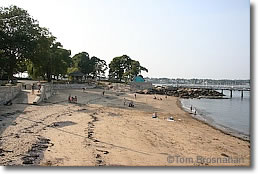
The park's pretty little beach.
There's metered parking next to the row of shops, fun arcades and eateries inland from the park.
The shops can meet your needs for sustinence and amusement.
Salem 1630: Pioneer Village
Built in 1930 to commemorate Salem's 300th anniversary, the Pioneer Village in Forest River Park (map) off West Street in Salem, 1.5 miles (2.4 km) south of Salem Common, showcases colonial architecture: dugouts, wigwams, thatched roof cottages, and the Governor's Faire House.
Costumed "interpreters" show you the governor's house, gardens such as the colonists might have cultivated, and other aspects of life in colonial Salem.
There's a beach and picnic area as well, so plan accordingly.
Pioneer Village is open only on Saturday and Sunday, mid-June through October, from 12 noon to 4 pm. Buy your tickets ($5) online from the affiliated Witch House, or at the gate when you arrive.
Frozen Fire Festival
In 2023, Salem organized its first Frozen Fire Festival in Charlotte Forten Park at 289 Derby Street (map), with fire performances, live ice sculpture carvings, fire installations, live music and a winter themed artisan market. More...
Salem Transportation
MBTA Commuter Rail trains and buses take you from Boston to Salem every 20 to 30 minutes, but it's more fun to take the fast Salem Fast Ferry at least one way. Coming from Boston by car (30 to 45 minutes), you'll want to study the options for parking in Salem.
In October, and especially around Hallowe'en it's particularly important not to take your car.
Ferryboat
From mid-May through October, the Salem Fast Ferry operated by Boston Harbor Cruises speeds between Boston's Long Wharf (map) and Salem Wharf (map) four or five times daily in each direction. The voyage takes about 55 minutes. More...
Train
MBTA Commuter Rail trains on the Rockport line run from Boston's North Station to Salem, Beverly, Gloucester, and Rockport. After Beverly, some trains go to Ipswich and Newburyport.
The train trip from Boston to Salem Intemodal Station, 252 Bridge Street (map), the town's train and bus station, takes about 30 minutes. Trains run about every 20 minutes during rush hours, every half-hour during the day, every hour at night and on weekends. More...
Bus
Salem is served by MBTA Bus 450 (Haymarket Station—Salem Depot), which leaves from Boston's Government Center near Boston's Haymarket subway station (Green Line or Orange Line) and terminates at Salem Internodal Station, 252 Bridge Street.
Buses leave Haymarket every 30 minutes during rush hours, every hour during the day Monday through Saturday, every 90 minutes on Sunday. Here's the schedule...
Under good traffic conditions, the bus trips take about an hour and end at the Salem Intermodal Station (Salem Depot, the MBTA Commuter Rail station; map), about 10 minutes' walk from Salem Common and most Salem attractions.
Car
The fastest way from Boston to Salem may be the least direct: take I-93 north to I-95 north, then MA Route 128 North, and take the exit marked for MA Route 114 and Salem (map). Speed is dependant on traffic, of course, and at rush-hour times on weekdays, this route may be slower. Consult your GPS or apps for traffic tie-ups.
A more direct route, via US 1, is not usually faster.
The most direct route, via MA Route 1A, may be slowest because it passes through many towns (and many traffic signals) along the way. MA Route 1A North becomes Lafayette Street in Salem.
Remember that in October, especially around Hallowe'en (October 31st), you should avoid driving. Take public transportation instead. More...
Note that routes and highway signs on the North Shore can be confusing. Routes are filled with turns, and signs may be inconspicuous or missing, so your GPS or smartphone map app will be highly useful.
Salem Hotels & Inns
Salem has at least a dozen hotels, inns and B&Bs.Many visitors to Salem, Massachusetts come on day-trips from Boston by car, bus, ferry, or MBTA Commuter Rail train, but if you'd like to stay overnight in this interesting city, there are numerous possibilities.
Salem itself has several historic hotels and inns, and there are many more modern lodgings in neighboring towns, the closest of which are Peabody and Beverly (map), with Danvers being a bit farther away (about 5 miles/8 km).
Salem Hotels Map with Prices
(Don't see the map? Click here!)
Best Salem Hotels
The Salem Inn
Three historic houses in the center of Salem have been restored to accept visitors in 40 guest rooms. The original Salem Inn at 7 Summer Street (map), is only a half block from the Witch House and two blocks from the Peabody Essex Museum. The inn's other houses, the West House, Curwen House and Peabody House, are nearby. Parking and continental breakfast are included in the rates. More...
Hawthorne Hotel
This restored 89-room hotel at 18 Washington Square West (map), at the southwest corner of Salem Common is within easy walking distance of all the important sights in Salem. Lots of wood paneling, brass chandeliers and old prints and paintings set a historical mood in the public rooms, though furnishings in the guest rooms are somewhat more modern. More...
Boston Marriott Peabody
If you're looking for a big, modern hotel, the 257-room Boston Marriott Peabody is less than 5 miles (12 minutes) west of Salem Common in the neighboring town of Peabody. Advantages here include an indoor heated swimming pool, hot tub and fitness center. More...
Nearby Marblehead has several delightful New England inns you should consider. More...
